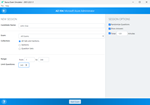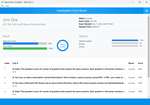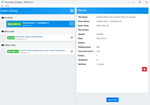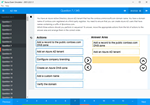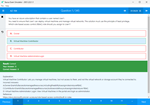Download Security-Professional.JN0-637.PassLeader.2025-01-24.42q.tqb
| Vendor: | Juniper |
| Exam Code: | JN0-637 |
| Exam Name: | Security-Professional |
| Date: | Jan 24, 2025 |
| File Size: | 238 KB |
How to open TQB files?
Files with TQB (Taurus Question Bank) extension can be opened by Taurus Exam Studio.
Purchase
Coupon: TAURUSSIM_20OFF
Discount: 20%
Demo Questions
Question 1
Your IPsec tunnel is configured with multiple security associations (SAs). Your SRX Series device supports the CoS-based IPsec VPNs with multiple IPsec SAs feature. You are asked to configure CoS for this tunnel. Which two statements are true in this scenario? (Choose two.)
- The local and remote gateways do not need the forwarding classes to be defined in the same order.
- A maximum of four forwarding classes can be configured for a VPN with the multi-sa forwarding- classes statement.
- The local and remote gateways must have the forwarding classes defined in the same order.
- A maximum of eight forwarding classes can be configured for a VPN with the multi-sa forwarding- classes statement.
Correct answer: AD
Question 2
You have deployed automated threat mitigation using Security Director with Policy Enforcer, Juniper ATP Cloud, SRX Series devices, Forescout, and third-party switches. In this scenario, which device is responsible for communicating directly to the third-party switches when infected hosts need to be blocked?
- Forescout
- Policy Enforcer
- Juniper ATP Cloud
- SRX Series Device
Correct answer: B
Explanation:
Policy Enforcer receives these policies and translates them into device-specific commands. It then communicates with the third-party switches (using protocols like SNMP, RADIUS, or vendor-specific APIs) to enforce those commands, such as blocking the infected hosts' MAC addresses or port access: - Centralized Enforcement: Policy Enforcer acts as the central point of enforcement for Security Director policies, ensuring consistent security across the network. Multi-Vendor Support: It can interact with a wide range of network devices, including switches from different vendors. - Automation: Policy Enforcer automates the policy enforcement process, enabling rapid response to threats. Policy Enforcer receives these policies and translates them into device-specific commands. It then communicates with the third-party switches (using protocols like SNMP, RADIUS, or vendor-specific APIs) to enforce those commands, such as blocking the infected hosts' MAC addresses or port access:
- Centralized Enforcement: Policy Enforcer acts as the central point of enforcement for Security Director policies, ensuring consistent security across the network. Multi-Vendor Support: It can interact with a wide range of network devices, including switches from different vendors.
- Automation: Policy Enforcer automates the policy enforcement process, enabling rapid response to threats.
Question 3
You want to create a connection for communication between tenant systems without using physical revenue ports on the SRX Series device. What are two ways to accomplish this task? (Choose two.)
- Use an external router.
- Use an interconnect VPLS switch.
- Use a secure wire.
- Use a point-to-point logical tunnel.
Correct answer: BD
Question 4
You have deployed an SRX Series device at your network edge to secure Internet-bound sessions for your local hosts using source NAT. You want to ensure that your users are able to interact with applications on the Internet that require more than one TCP session for the same application session. Which two features would satisfy this requirement? (Choose two.)
- address persistence
- STUN
- persistent NAT
- double NAT
Correct answer: AC
Explanation:
Address persistence ensures that the same NAT IP address is used for all sessions originating from a single source IP. Persistent NAT maintains connections for applications needing multiple sessions, like VoIP. For applications that require multiple TCP sessions for the same application session (such as VoIP or certain online games), the SRX device needs to handle NAT properly to maintain session continuity. Address persistence ensures that the same NAT IP address is used for all sessions originating from a single source IP. Persistent NAT maintains connections for applications needing multiple sessions, like VoIP. For applications that require multiple TCP sessions for the same application session (such as VoIP or certain online games), the SRX device needs to handle NAT properly to maintain session continuity.
Question 5
You want to use a security profile to limit the system resources allocated to user logical systems. In this scenario, which two statements are true? (Choose two.)
- If nothing is specified for a resource, a default reserved resource is set for a specific logical system.
- If you do not specify anything for a resource, no resource is reserved for a specific logical system, but the entire system can compete for resources up to the maximum available.
- One security profile can only be applied to one logical system.
- One security profile can be applied to multiple logical systems.
Correct answer: BD
Explanation:
When using security profiles to limit system resources in Juniper logical systems: - No Resource Specification (Answer B): If a resource limit is not specified for a logical system, no specific amount of system resources is reserved for it. Instead, the logical system competes for resources along with others in the system, up to the maximum available. This allows flexible resource allocation, where logical systems can scale based on actual demand rather than predefined limits. - Multiple Logical Systems per Security Profile (Answer D): A single security profile can be applied to multiple logical systems. This allows administrators to define resource limits once in a profile and apply it across several logical systems, simplifying management and ensuring consistency across different environments. These principles ensure efficient and flexible use of system resources within a multi-tenant or multi-logical-system environment. When using security profiles to limit system resources in Juniper logical systems:
- No Resource Specification (Answer B): If a resource limit is not specified for a logical system, no specific amount of system resources is reserved for it. Instead, the logical system competes for resources along with others in the system, up to the maximum available. This allows flexible resource allocation, where logical systems can scale based on actual demand rather than predefined limits.
- Multiple Logical Systems per Security Profile (Answer D): A single security profile can be applied to multiple logical systems. This allows administrators to define resource limits once in a profile and apply it across several logical systems, simplifying management and ensuring consistency across different environments.
These principles ensure efficient and flexible use of system resources within a multi-tenant or multi-logical-system environment.
HOW TO OPEN VCE FILES
Use VCE Exam Simulator to open VCE files

HOW TO OPEN VCEX FILES
Use ProfExam Simulator to open VCEX files


ProfExam at a 20% markdown
You have the opportunity to purchase ProfExam at a 20% reduced price
Get Now!